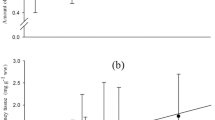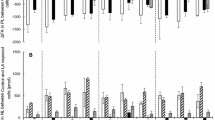Abstract
Atlantic salmon post-smolts were fed diets containing either fish oils (Fosol, FO and Marinol, MO) rich in long-chain n-3 polyunsaturated fatty acids (PUFA), or plant oils rich in 18:2n-6 (sunflower oil, SO) or 18:3n-3 (linseed oil, LO) for 12 wk. The major PUFA in individual phospholipids from gill and kidney were related to the dietary lipid intake. Levels of n-6 PUFA were highest while levels of n-3 PUFA were lowest in fish fed SO. Fish fed LO generally had lower levels of 20:4n-6 compared to the other treatments while fish fed SO generally had the highest levels of 20:4n-6. In all phospholipid classes except phosphatidylinositol (PI) 20:5n-3 was greatest in fish fed MO followed by FO, LO, and SO. In PI, 20:5n-3 was also highest in fish fed MO but those fed LO contained more 20:5n-3 than those fed FO. This resulted in the ratio of the eicosanoid precursors, 20:4n-6/20:5n-3, being significantly greater in fish fed SO, for all phospholipid classes, compared to fish fed the other three dietary oils. The activity of gill phospholipase A was greatest in fish fed FO and was lowest in fish fed SO. The concentration of PGF3α was significantly increased in gill homogenates from fish fed MO compared to the other three treatments while PGF2α was significantly increased in fish fed SO compared to those fed LO. The concentration of PGE3 was significantly reduced in kidney homogenates from fish fed SO compared to the other three treatments while PGE2 was significantly increased in fish fed SO compared to those fed either FO or LO.
Similar content being viewed by others
Abbreviations
- AA:
-
arachidonic acid
- ANOVA:
-
analysis of variance
- DHA:
-
docosahexaenoic acid
- EPA:
-
eicosapentaenoic acid
- FO:
-
Fosol fish oil
- HETE:
-
hydroxy eicosatetraenoic acid
- HPTLC:
-
high-performance liquid chromatography
- LO:
-
linseed oil
- MO:
-
Marinol fish oil
- PC:
-
phosphatidylcholine
- PE:
-
phosphatidylethanolamine
- PGE:
-
prostaglanding E
- PGF:
-
prostaglandin F
- PI:
-
phosphatidylinositol
- PS:
-
phosphatidylserine
- PUFA:
-
polyunsaturated fatty acid
- SO:
-
sunflower oil
- TLC:
-
thin-layer chromatography
References
Kinsella, J.E. (1987) Effects of Polyunsaturated Fatty Acids on Factors Related to Cardiovascular Disease,Am. J. Cardiol. 60, 23G-32G.
Weber, P.C. (1990) The Modification of the Arachidonic Acid Cascade by n-3 Fatty Acids, inAdvances in Prostaglandin, Thromboxane and Leukotriene Research (Samuelsson, B., Dahlen, S-E., and Hedqvist, P., eds.) Raven Press Inc., New York, Vol. 20, pp. 232–240.
Lands, W.E.M. (1986)Fish and Human Health, Academic Press, London.
Simopoulos, A.P., Kifer, R.R., and Wykes, A.A. (1991) ω3 Fatty Acids: Research Advances in Support of the Field Since June 1985, inHealth Effects of ω3 Fatty Acids in Seafoods (Simopoulos, A.P., Kifer, R.R., Martin, R.E., and Barlow, S.E., eds.) Karger Press, Basel, pp. 51–73.
Terano, T., Salmon, J.A., Higgs, G.A., and Moncada, S. (1986) Eicosapentaenoic Acid as a Modulator of Inflammation. Effect on Prostaglandin and Leukotriene Synthesis,Biochem. Pharmacol. 35, 779–785.
Lands, W.E.M., Lettelier, P.E., Rome, L.H., and Vanderhoek, J.Y. (1973) Inhibition of Prostaglandin Biosynthesis,Adv. Biosci. 9, 15–28.
Chanmugam, P.S., Boudreau, M.D., and Hwang, D.H. (1991) Dietary (n-3) Fatty Acids Alter Fatty Acid Composition and Prostaglandin Synthesis in Rat Testis,J. Nutr. 121, 1173–1178.
Galli, C. (1980) Dietary Influences on Prostaglandin Synthesis,Adv. Nutr. Res. 3, 99–106.
Brenner, R.R. (1981) Nutritional and Hormonal Factors Influencing Desaturation of Essential Fatty Acids,Prog. Lipid Res. 20, 41–47.
Murota, S. (1982)Biochemistry of Prostaglandins, Tokyo Kagaku Doujin, Tokyo, pp. 74–84.
Sanders, T.A.B. (1985) The Importance of Eicosapentaenoic and Docosahexaenoic Acids, inThe Role of Fats in Human Nutrition (Padly, F.B., and Podmore, J., eds.) Ellis Horwood Ltd., Chichester, pp. 101–116.
Horrobin, D.F. (1983) The Regulation of Prostaglandin Biosynthesis by the Manipulation of Essential Fatty Acid Metabolism,Rev. Pure Apl. Sci. 4, 339–383.
Henderson, R.J., and Tocher, D.R. (1987) The Lipid Biochemistry of Freshwater Fish,Prog. Lipid Res. 26, 281–347.
Sargent, J.R., Henderson, R.J., and Tocher, D.R. (1989) The Lipids, inFish Nutrition (Halver, J.E., ed.) Academic Press, New York, pp. 154–218.
Mustafa, T., and Srivastava, K.C. (1989) Prostaglandins (eicosanoids) and Their Role in Ectothermic Organisms,Adv. Comp. Environ. Physiol. 5, 157–207.
Tocher, D.R., and Sargent, J.R. (1987) The Effects of Calcium Ionophore A23187 on the Metabolism of Arachidonic and Eicosapentaenoic Acids in Neutrophils from a Marine Teleost Fish Rich in (n-3) Polyunsaturated Fatty Acids,Comp. Biochem. Physiol. 87B, 733–739.
Henderson, R.J., Bell, M.V., and Sargent, J.R. (1985) The Conversion of Polyunsaturated Fatty Acids to Prostaglandins by Tissue Homogenates of the Turbot,Scophthalmus maximus (L.),J. Exp. Mar. Biol. Ecol. 85, 93–99.
Bell, J.G., Tocher, D.R., and Sargent, J.R. (1994) Effect of Supplementation with 20:3(n-6), 20:4(n-6) and 20:5(n-3) on the Production of Prostaglandins E and F of the 1-, 2- and 3-Series in Turbot (Scophthalmus maximus) Brain Astroglial Cells in Primary Culture,Biochim. Biophys. Acta 1211, 335–342.
Bell, J.G., Sargent, J.R., and Raynard, R.S. (1992) Effects of Increasing Dietary Linoleic Acid on Phospholipid Fatty Acid Composition and Eicosanoid Production in Leucocytes and Gill Cells of Atlantic Salmon (Salmo salar),Prostaglandins, Leukotrienes and Essent. Fatty Acids 45, 197–206.
Bell, J.G., Dick, J.R., McVicar, A.H., Sargent, J.R., and Thompson, K.D. (1993) Dietary Sunflower, Linseed and Fish Oils Affect Phospholipid Fatty Acid Composition, Development of Cardiac Lesions, Phospholipase Activity and Eicosanoid Production in Atlantic Salmon (Salmo salar),Prostaglandins, Leukotrienes and Essent. Fatty Acids 49, 665–673.
Massferrer, J.L., Rios, A.P., and Schwartzman, M.L. (1990). Inhibition of Renal, Cardiac and Corneal (Na+−K+) ATPase by 12(R)-Hydroxyeicosatetraenoic Acid,Biochem. Pharmacol. 39, 1971–1974.
Ogata, H., Nomura, T., and Hata, M. (1978) Prostaglandin Biosynthesis in Tissue Homogenates of Marine Animals,Bull. Jap. Soc. Sci. Fish 44, 1367–1370.
Christ, E.J., and Van Dorp, D.A. (1972) Comparative Aspects of Prostaglandin Biosynthesis in Animal Tissues,Biochim. Biophys. Acta 270, 537–545.
Wales, N.A.M., and Gaunt, T. (1986) Hemodynamic, Renal, and Steroidogenic Actions of Prostaglandins E1, E2, A2 and F2α in European Eels,Gen. Comp. Endocrinol. 62, 327–334.
Brown, J.A., Gray, C.J., Hattersley, G., and Robinson, J. (1991) Prostaglandins in the Kidney, Urinary Bladder and Gills of the Rainbow Trout and European Eel Adapted to Freshwater and Seawater.Gen. Comp. Endocrinol. 84, 328–335.
Van Praag, D., Farber, S.J., Minkin, E., and Primor, N. (1987) Production of Eicosanoids by the Killifish Gills and Opercular Epithelia and Their Effect on Active Transport of Ions,Gen. Comp. Endocrinol. 67, 50–57.
Bell, J.G., Raynard, R.S., and Sargent, J.R. (1991) The Effect of Dietary Linoleic Acid on the Fatty Acid Composition of the Individual Phospholipids and Lipoxygenase Products from Gills and Leucocytes of Atlantic Salmon (Salmo salar),Lipids 26, 445–450.
U.S. National Research Council (1981) Nutrient Requirement of Coldwater Fishes, Washington, D.C., National Academy Press.
Folch, J., Lees, M., and Sloane-Stanley, G.H. (1957) A Simple Method for the Isolation and Purification of Total Lipids from Animal Tissues,J. Biol. Chem. 226, 497–509.
Ackman, R.G. (1980) Fish Lipids Part 1, inAdvances in Fish Science and Technology (Connell, J.J., ed.) Fishing News Books, Farnham, pp. 87–103.
Powell, W.S. (1982) Rapid Extraction of Arachidonic Acid Metabolites from Biological Samples Using Octadecyl Silica,Methods Enzymol. 86, 467–477.
Szymanska, G., Pikula, S., and Zbrowski, J. (1991) Effect of Hyper- and Hypothyroidism on Phospholipid Fatty Acid Composition and Phospholipase Activity in Sarcolemma of Rabbit Cardiac Muscle,Biochim. Biophys. Acta 1083, 265–270.
Garg, M.L., Thomson, A.B.R., and Clandinin, M.T. (1990) Interactions of Saturated, n-6 and n-3 Polyunsaturated Fatty Acids to Modulate Arachidonic Acid Metabolism,J. Lipid Res. 31, 271–277.
Bell, M.V., Simpson, C.M.F., and Sargent, J.R. (1983) (n-3) and (n-6) Polyunsaturated Fatty Acid in the Salt-Secreting Epithelia from Two Marine Fish Species,Lipids 18, 720–726.
German, J.B., and Hu, M.-L. (1990) Oxidant Stress Inhibits the Endogenous Production of Lipoxygenase Metabolites in Rat Lungs and Fish Gills,Free Rad. Biol. Med. 8, 441–448.
Spector, A.A., and Yorek, M.A. (1985) Membrane Lipid Composition and Cellular Function,J. Lipid Res. 26, 1015–1035.
Grataroli, R., Leonardi, J., Charbonnier, M., Lafont, H., and Nalbone, G. (1988) Effects of Dietary Corn Oil and Salmon Oil on Lipids and PGE2 in Rat Gastric Mucosa,Lipids 23, 666–670.
Lee, J.H., Sugano, M., and Ide, T. (1988) Effects of Various Combinations of ω3 and ω6 Polyunsaturated Fats with Saturated Fat on Serum Lipid Levels and Eicosanoid Production in Rats,J. Nutr. Sci. Vitaminol. 34, 117–129.
Nalbone, G., Grynberg, A., Chevalier, A., Leonardi, J., Termine, E., and Lafont, H. (1990) Phospholipase A Activity of Cultured Rat Ventricular Myocyte Is Affected by the Nature of Cellular Polyunsaturated Fatty Acids,Lipids 25, 301–306.
Burack, W.R. and Biltonen, R.L. (1994) Lipid Bilayer Heterogeneities and Modulation of Phospholipase A2 Activity,Chem. Phys. Lipids 73, 209–222.
Malis, C.D., Weber, P.C., Leaf A., and Bonventre, J.V. (1990) Incorporation of Marine Lipids into Mitochondrial Membranes Increases Susceptibility to Damage by Calcium and Reactive Oxygen Species: Evidence for Enhanced Activation of Phospholipase A2 in Mitochondria Enriched with n-3 Fatty Acids,Proc. Natl. Acad. Sci. USA 87, 8845–8849.
Horrobin, D.F. (1992) Nutritional and Medical Importance of Gamma-Linolenic Acid,Prog. Lipid Res. 31, 163–194.
Maetz, J. (1974) inBiochemical and Biophysical Perspectives in Marine Biology (Malins, D.C., and Sargent, J.R., eds.) Vol. 1, pp. 1–167, Academic Press, London.
Zadunaisky, J.A. (1984) The Chloride Cells: Active Transport of Chloride and the Paracellular Pathways, inFish Physiology (Hoar, W.S., Randall, D.J., and Brett, J.R., eds.) pp. 13–176, Academic Press, London.
Brown, J.A., and Bucknall, R.M. (1986) Antidiuretic and Cardiovascular Actions of PGE2 in the Rainbow TroutSalmo gairdneri, Gen. Comp. Endocrinol. 61, 330–337.
Wales, N.A.M. (1988) Hormone Studies inMyxine glutinosa: Effects of the Eicosanoids Arachidonic Acid, Prostaglandin E1, E2, A2, F2α, Thromboxane B2 and Indomethacin on Plasma Cortisol, Blood Pressure, Urine Flow and Electrolyte Balance,J. Comp. Physiol. B 158, 621–626.
Beckman, B., and Mustafa, T. (1992) Arachidonic Acid Metabolism in Gill Homogenate and Isolated Gill Cells from Rainbow Trout,Oncorhynchus mykiss: The Effect of Osmolality, Electrolytes and Prolactin,Fish Physiol. Biochem. 10, 213–222.
Lands, W.E.M. (1989) Differences in n-3 and n-6 Eicosanoid Precursors, inAdvances in Prostaglandin, Thromboxane and Leukotriene Research (Samuelsson, B., Wong, P.Y.K., and Sun, F.F., eds.) Vol. 19, Raven Press, New York, pp. 602–605.
Knight, J., and Rowley, A.F. (1995) Immunoregulatory Activities of Eicosanoids in the Rainbow Trout (Oncoryhnchus mykiss),Immunology 85, 389–393.
Author information
Authors and Affiliations
About this article
Cite this article
Bell, J.G., Farndale, B.M., Dick, J.R. et al. Modification of membrane fatty acid composition, eicosanoid production, and phospholipase a activity in Atlantic Salmon (Salmo salar) gill and kidney by dietary lipid. Lipids 31, 1163–1171 (1996). https://doi.org/10.1007/BF02524291
Received:
Revised:
Accepted:
Issue Date:
DOI: https://doi.org/10.1007/BF02524291




